Nursing Case Study: Managing Fluid, Electrolyte Imbalance in Patients
VerifiedAdded on 2023/06/05
|9
|2347
|83
Case Study
AI Summary
This case study addresses impaired fluid and electrolyte balance in two patients: a 4-year-old child (Anna) and an 85-year-old adult (Mr. McAdams), both presenting with diarrhea and vomiting. The analysis identifies relevant data, interprets the underlying pathophysiology, and highlights developmental differences in expressed symptoms. It defines a goal for care, outlines nurse-initiated and collaborative nursing interventions, and discusses the evaluation of these interventions, emphasizing physical changes that indicate effectiveness. Key issues covered include hypovolemia, dehydration, electrolyte imbalances (sodium, potassium), and the impact of age on fluid balance. The study emphasizes the importance of fluid administration, patient monitoring, and a collaborative approach involving nurses, physicians, and nutritionists to achieve stable fluid volume and improved patient outcomes. Desklib provides access to this and other solved assignments.

Running head: CLINICAL CASE 1
CLINICAL CASE
Student’s Name
Institutional Affiliation
Course
Instructor
Date
CLINICAL CASE
Student’s Name
Institutional Affiliation
Course
Instructor
Date
Paraphrase This Document
Need a fresh take? Get an instant paraphrase of this document with our AI Paraphraser

CLINICAL CASE
Introduction
Developmental and chronological gender, age, support, life experiences, and health
status impacts on an individual response to illness. The chosen priority problem for this essay
is impaired fluid and electrolyte balance. In relation to impaired fluid and electrolyte balance,
the essay will focus on both case studies of Anna, 4years old and Mc Adams, 85 years old.
The essay will identify relevant data in relation to the priority problem and give its
interpretation in relation to the underlying pathophysiology of the problem. The paper will
highlight the developmental differences and similarities in signs and symptoms expressed by
both patients in the cases. The paper will define a goal for care and nursing interventions
(nurse-initiated and collaborative) for the chosen priority problem. Lastly, the paper will
discuss the evaluation of the implemented nursing interventions in each case highlighting the
physical changes that would indicate the effectiveness of the nursing interventions.
Impaired Fluid and Electrolyte Balance
From both case studies, both Anna and Mc Adams had a history of diarrhea and
vomiting for two days. They were unable to tolerate any oral fluids given. They both had
three episodes of watery bowel motions and vomited up the small amount of water given
shortly after consumption. On assessment, Anna’s body temperature is 38.20C, body weight
is 16kg, respiratory rate 22, blood pressure is 88/50 mmHg, heart rate is 118. For McAdams,
temperature is 38.20C, respiratory rate is 22, blood pressure is 105/60, and heart rate of 108
which is irregular. In both cases, there is nil urine output within 8 hours.
The fluids and electrolyte balance in the body must be in total maintenance to keep
the brain, muscles, and nerves in proper function. Fluid and electrolyte imbalance can be due
to hypovolemia hypervolemia and normovolemia with poor fluid dissemination. One of the
Introduction
Developmental and chronological gender, age, support, life experiences, and health
status impacts on an individual response to illness. The chosen priority problem for this essay
is impaired fluid and electrolyte balance. In relation to impaired fluid and electrolyte balance,
the essay will focus on both case studies of Anna, 4years old and Mc Adams, 85 years old.
The essay will identify relevant data in relation to the priority problem and give its
interpretation in relation to the underlying pathophysiology of the problem. The paper will
highlight the developmental differences and similarities in signs and symptoms expressed by
both patients in the cases. The paper will define a goal for care and nursing interventions
(nurse-initiated and collaborative) for the chosen priority problem. Lastly, the paper will
discuss the evaluation of the implemented nursing interventions in each case highlighting the
physical changes that would indicate the effectiveness of the nursing interventions.
Impaired Fluid and Electrolyte Balance
From both case studies, both Anna and Mc Adams had a history of diarrhea and
vomiting for two days. They were unable to tolerate any oral fluids given. They both had
three episodes of watery bowel motions and vomited up the small amount of water given
shortly after consumption. On assessment, Anna’s body temperature is 38.20C, body weight
is 16kg, respiratory rate 22, blood pressure is 88/50 mmHg, heart rate is 118. For McAdams,
temperature is 38.20C, respiratory rate is 22, blood pressure is 105/60, and heart rate of 108
which is irregular. In both cases, there is nil urine output within 8 hours.
The fluids and electrolyte balance in the body must be in total maintenance to keep
the brain, muscles, and nerves in proper function. Fluid and electrolyte imbalance can be due
to hypovolemia hypervolemia and normovolemia with poor fluid dissemination. One of the
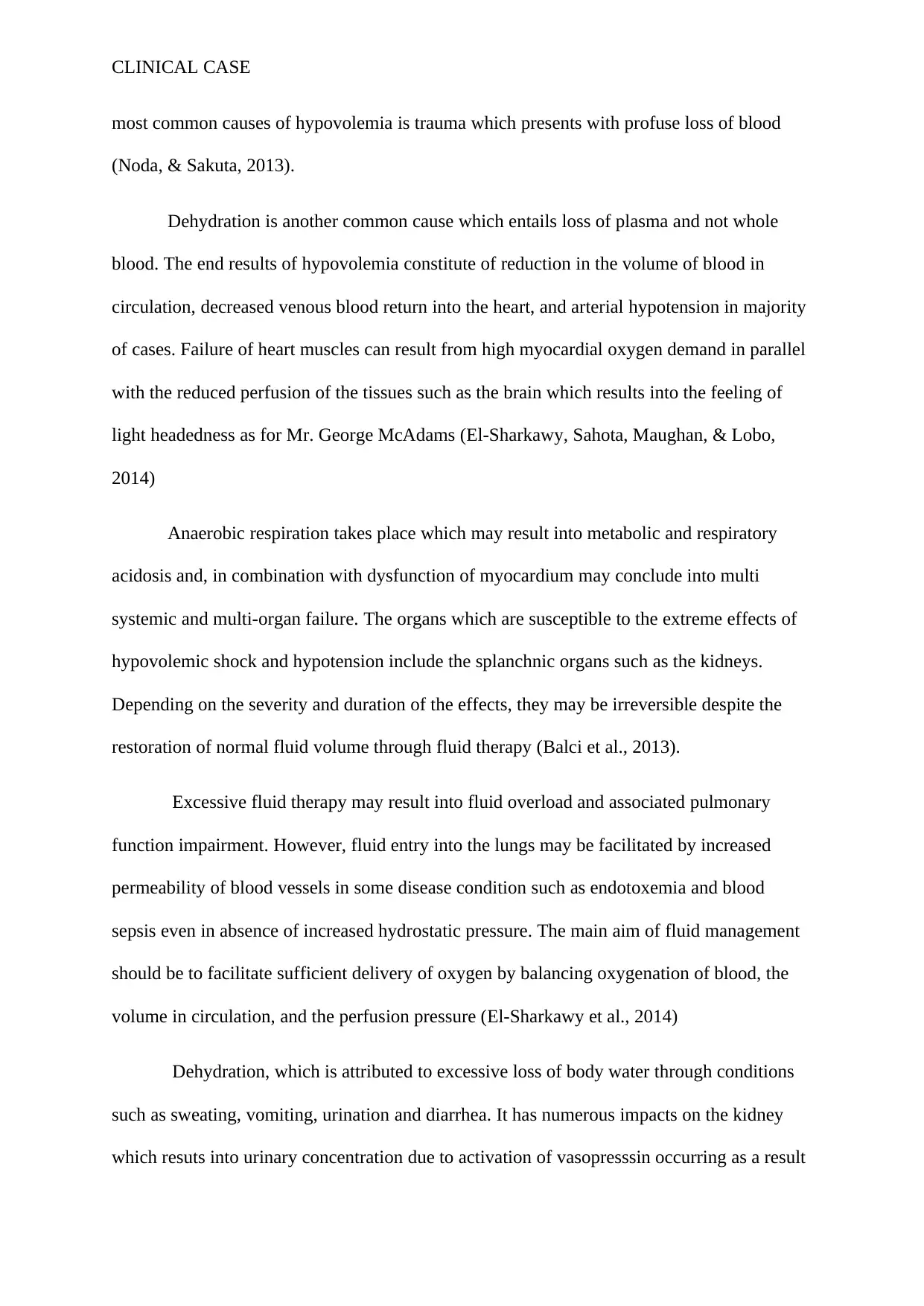
CLINICAL CASE
most common causes of hypovolemia is trauma which presents with profuse loss of blood
(Noda, & Sakuta, 2013).
Dehydration is another common cause which entails loss of plasma and not whole
blood. The end results of hypovolemia constitute of reduction in the volume of blood in
circulation, decreased venous blood return into the heart, and arterial hypotension in majority
of cases. Failure of heart muscles can result from high myocardial oxygen demand in parallel
with the reduced perfusion of the tissues such as the brain which results into the feeling of
light headedness as for Mr. George McAdams (El-Sharkawy, Sahota, Maughan, & Lobo,
2014)
Anaerobic respiration takes place which may result into metabolic and respiratory
acidosis and, in combination with dysfunction of myocardium may conclude into multi
systemic and multi-organ failure. The organs which are susceptible to the extreme effects of
hypovolemic shock and hypotension include the splanchnic organs such as the kidneys.
Depending on the severity and duration of the effects, they may be irreversible despite the
restoration of normal fluid volume through fluid therapy (Balci et al., 2013).
Excessive fluid therapy may result into fluid overload and associated pulmonary
function impairment. However, fluid entry into the lungs may be facilitated by increased
permeability of blood vessels in some disease condition such as endotoxemia and blood
sepsis even in absence of increased hydrostatic pressure. The main aim of fluid management
should be to facilitate sufficient delivery of oxygen by balancing oxygenation of blood, the
volume in circulation, and the perfusion pressure (El-Sharkawy et al., 2014)
Dehydration, which is attributed to excessive loss of body water through conditions
such as sweating, vomiting, urination and diarrhea. It has numerous impacts on the kidney
which resuts into urinary concentration due to activation of vasopresssin occurring as a result
most common causes of hypovolemia is trauma which presents with profuse loss of blood
(Noda, & Sakuta, 2013).
Dehydration is another common cause which entails loss of plasma and not whole
blood. The end results of hypovolemia constitute of reduction in the volume of blood in
circulation, decreased venous blood return into the heart, and arterial hypotension in majority
of cases. Failure of heart muscles can result from high myocardial oxygen demand in parallel
with the reduced perfusion of the tissues such as the brain which results into the feeling of
light headedness as for Mr. George McAdams (El-Sharkawy, Sahota, Maughan, & Lobo,
2014)
Anaerobic respiration takes place which may result into metabolic and respiratory
acidosis and, in combination with dysfunction of myocardium may conclude into multi
systemic and multi-organ failure. The organs which are susceptible to the extreme effects of
hypovolemic shock and hypotension include the splanchnic organs such as the kidneys.
Depending on the severity and duration of the effects, they may be irreversible despite the
restoration of normal fluid volume through fluid therapy (Balci et al., 2013).
Excessive fluid therapy may result into fluid overload and associated pulmonary
function impairment. However, fluid entry into the lungs may be facilitated by increased
permeability of blood vessels in some disease condition such as endotoxemia and blood
sepsis even in absence of increased hydrostatic pressure. The main aim of fluid management
should be to facilitate sufficient delivery of oxygen by balancing oxygenation of blood, the
volume in circulation, and the perfusion pressure (El-Sharkawy et al., 2014)
Dehydration, which is attributed to excessive loss of body water through conditions
such as sweating, vomiting, urination and diarrhea. It has numerous impacts on the kidney
which resuts into urinary concentration due to activation of vasopresssin occurring as a result
⊘ This is a preview!⊘
Do you want full access?
Subscribe today to unlock all pages.

Trusted by 1+ million students worldwide

CLINICAL CASE
rising osmolarity of serum due to body water loss (Rhoda, Porter, & Quintini, 2011).
Dehydration classically impacts in pre-renal state which is associated with intrarenal
vasoconstriction, but there is relative maintenance of the rate of glomerular filtration. In
severe volume depletion the glomerular filtration rate reduces close to zero like in these two
cases scenarios, though it is reversible with hydration, loss of blood supply results in acute
kidney injury (Farthing et al., 2013).
Water is of critical importance as it helps in getting rid of body waste in urine form as
well as keeping the blood vessels open so that blood with nutrients flow freely into the kidney
alongside other organs. Dehydration can result in accumulation of acids and wastes and can
block the renal organs with myoglobin which as a result lead to kidney injury. Impaired
kidney functioning and reduced glomerular filtration rate results in little or no urine output.
For both cases, Anna and McAdams have nil urine output (Dekate, Jayashree, & Singhi,
2013).
The major bodily electrolytes which are involved in homeostasis, and whose
imbalance lead to patient deterioration include sodium, potassium, calcium, phosphate and
magnesium. The normal sodium ranges are 135-145 meq/L. It plays a significant and primary
role in the body fluid balance, nervous system and body muscles. Its abundant in plasma were
body water is attracted towards. High levels of this electrolyte, that is hypernatremia, can be
due to various conditions namely; dehydration, fever, diabetes insipidus, vomiting, diarrhea,
and others. The signs and symptoms include thirst, dry mucous membranes among others.
Also, low levels of sodium can be caused by severe diarrhea or vomiting with others (Mount,
2013).
According to the case studies, both patients had a history of diarrhea and vomiting for
two days. Diarrhea and vomiting are commonly associated with excessive loss of body
rising osmolarity of serum due to body water loss (Rhoda, Porter, & Quintini, 2011).
Dehydration classically impacts in pre-renal state which is associated with intrarenal
vasoconstriction, but there is relative maintenance of the rate of glomerular filtration. In
severe volume depletion the glomerular filtration rate reduces close to zero like in these two
cases scenarios, though it is reversible with hydration, loss of blood supply results in acute
kidney injury (Farthing et al., 2013).
Water is of critical importance as it helps in getting rid of body waste in urine form as
well as keeping the blood vessels open so that blood with nutrients flow freely into the kidney
alongside other organs. Dehydration can result in accumulation of acids and wastes and can
block the renal organs with myoglobin which as a result lead to kidney injury. Impaired
kidney functioning and reduced glomerular filtration rate results in little or no urine output.
For both cases, Anna and McAdams have nil urine output (Dekate, Jayashree, & Singhi,
2013).
The major bodily electrolytes which are involved in homeostasis, and whose
imbalance lead to patient deterioration include sodium, potassium, calcium, phosphate and
magnesium. The normal sodium ranges are 135-145 meq/L. It plays a significant and primary
role in the body fluid balance, nervous system and body muscles. Its abundant in plasma were
body water is attracted towards. High levels of this electrolyte, that is hypernatremia, can be
due to various conditions namely; dehydration, fever, diabetes insipidus, vomiting, diarrhea,
and others. The signs and symptoms include thirst, dry mucous membranes among others.
Also, low levels of sodium can be caused by severe diarrhea or vomiting with others (Mount,
2013).
According to the case studies, both patients had a history of diarrhea and vomiting for
two days. Diarrhea and vomiting are commonly associated with excessive loss of body
Paraphrase This Document
Need a fresh take? Get an instant paraphrase of this document with our AI Paraphraser
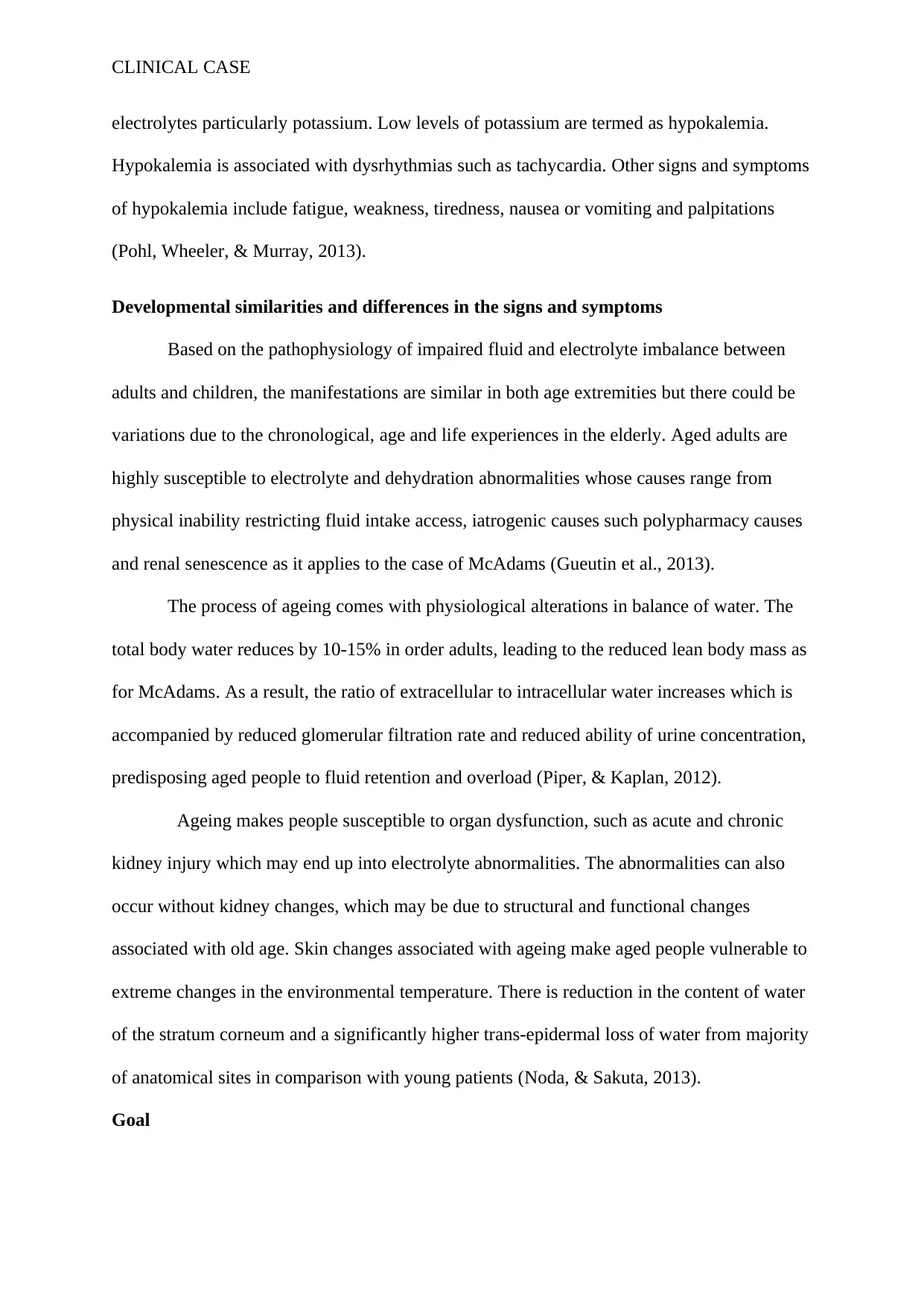
CLINICAL CASE
electrolytes particularly potassium. Low levels of potassium are termed as hypokalemia.
Hypokalemia is associated with dysrhythmias such as tachycardia. Other signs and symptoms
of hypokalemia include fatigue, weakness, tiredness, nausea or vomiting and palpitations
(Pohl, Wheeler, & Murray, 2013).
Developmental similarities and differences in the signs and symptoms
Based on the pathophysiology of impaired fluid and electrolyte imbalance between
adults and children, the manifestations are similar in both age extremities but there could be
variations due to the chronological, age and life experiences in the elderly. Aged adults are
highly susceptible to electrolyte and dehydration abnormalities whose causes range from
physical inability restricting fluid intake access, iatrogenic causes such polypharmacy causes
and renal senescence as it applies to the case of McAdams (Gueutin et al., 2013).
The process of ageing comes with physiological alterations in balance of water. The
total body water reduces by 10-15% in order adults, leading to the reduced lean body mass as
for McAdams. As a result, the ratio of extracellular to intracellular water increases which is
accompanied by reduced glomerular filtration rate and reduced ability of urine concentration,
predisposing aged people to fluid retention and overload (Piper, & Kaplan, 2012).
Ageing makes people susceptible to organ dysfunction, such as acute and chronic
kidney injury which may end up into electrolyte abnormalities. The abnormalities can also
occur without kidney changes, which may be due to structural and functional changes
associated with old age. Skin changes associated with ageing make aged people vulnerable to
extreme changes in the environmental temperature. There is reduction in the content of water
of the stratum corneum and a significantly higher trans-epidermal loss of water from majority
of anatomical sites in comparison with young patients (Noda, & Sakuta, 2013).
Goal
electrolytes particularly potassium. Low levels of potassium are termed as hypokalemia.
Hypokalemia is associated with dysrhythmias such as tachycardia. Other signs and symptoms
of hypokalemia include fatigue, weakness, tiredness, nausea or vomiting and palpitations
(Pohl, Wheeler, & Murray, 2013).
Developmental similarities and differences in the signs and symptoms
Based on the pathophysiology of impaired fluid and electrolyte imbalance between
adults and children, the manifestations are similar in both age extremities but there could be
variations due to the chronological, age and life experiences in the elderly. Aged adults are
highly susceptible to electrolyte and dehydration abnormalities whose causes range from
physical inability restricting fluid intake access, iatrogenic causes such polypharmacy causes
and renal senescence as it applies to the case of McAdams (Gueutin et al., 2013).
The process of ageing comes with physiological alterations in balance of water. The
total body water reduces by 10-15% in order adults, leading to the reduced lean body mass as
for McAdams. As a result, the ratio of extracellular to intracellular water increases which is
accompanied by reduced glomerular filtration rate and reduced ability of urine concentration,
predisposing aged people to fluid retention and overload (Piper, & Kaplan, 2012).
Ageing makes people susceptible to organ dysfunction, such as acute and chronic
kidney injury which may end up into electrolyte abnormalities. The abnormalities can also
occur without kidney changes, which may be due to structural and functional changes
associated with old age. Skin changes associated with ageing make aged people vulnerable to
extreme changes in the environmental temperature. There is reduction in the content of water
of the stratum corneum and a significantly higher trans-epidermal loss of water from majority
of anatomical sites in comparison with young patients (Noda, & Sakuta, 2013).
Goal
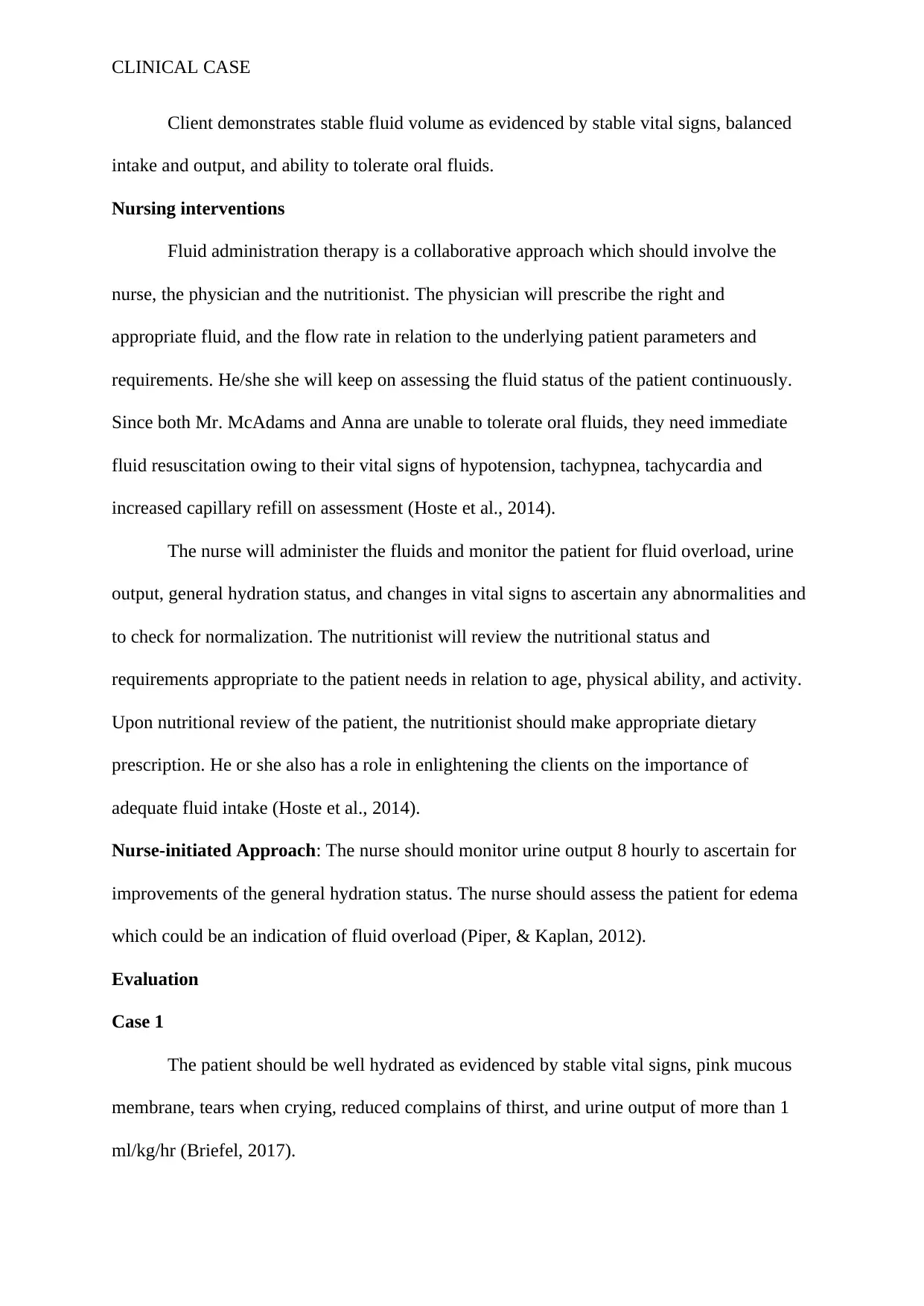
CLINICAL CASE
Client demonstrates stable fluid volume as evidenced by stable vital signs, balanced
intake and output, and ability to tolerate oral fluids.
Nursing interventions
Fluid administration therapy is a collaborative approach which should involve the
nurse, the physician and the nutritionist. The physician will prescribe the right and
appropriate fluid, and the flow rate in relation to the underlying patient parameters and
requirements. He/she she will keep on assessing the fluid status of the patient continuously.
Since both Mr. McAdams and Anna are unable to tolerate oral fluids, they need immediate
fluid resuscitation owing to their vital signs of hypotension, tachypnea, tachycardia and
increased capillary refill on assessment (Hoste et al., 2014).
The nurse will administer the fluids and monitor the patient for fluid overload, urine
output, general hydration status, and changes in vital signs to ascertain any abnormalities and
to check for normalization. The nutritionist will review the nutritional status and
requirements appropriate to the patient needs in relation to age, physical ability, and activity.
Upon nutritional review of the patient, the nutritionist should make appropriate dietary
prescription. He or she also has a role in enlightening the clients on the importance of
adequate fluid intake (Hoste et al., 2014).
Nurse-initiated Approach: The nurse should monitor urine output 8 hourly to ascertain for
improvements of the general hydration status. The nurse should assess the patient for edema
which could be an indication of fluid overload (Piper, & Kaplan, 2012).
Evaluation
Case 1
The patient should be well hydrated as evidenced by stable vital signs, pink mucous
membrane, tears when crying, reduced complains of thirst, and urine output of more than 1
ml/kg/hr (Briefel, 2017).
Client demonstrates stable fluid volume as evidenced by stable vital signs, balanced
intake and output, and ability to tolerate oral fluids.
Nursing interventions
Fluid administration therapy is a collaborative approach which should involve the
nurse, the physician and the nutritionist. The physician will prescribe the right and
appropriate fluid, and the flow rate in relation to the underlying patient parameters and
requirements. He/she she will keep on assessing the fluid status of the patient continuously.
Since both Mr. McAdams and Anna are unable to tolerate oral fluids, they need immediate
fluid resuscitation owing to their vital signs of hypotension, tachypnea, tachycardia and
increased capillary refill on assessment (Hoste et al., 2014).
The nurse will administer the fluids and monitor the patient for fluid overload, urine
output, general hydration status, and changes in vital signs to ascertain any abnormalities and
to check for normalization. The nutritionist will review the nutritional status and
requirements appropriate to the patient needs in relation to age, physical ability, and activity.
Upon nutritional review of the patient, the nutritionist should make appropriate dietary
prescription. He or she also has a role in enlightening the clients on the importance of
adequate fluid intake (Hoste et al., 2014).
Nurse-initiated Approach: The nurse should monitor urine output 8 hourly to ascertain for
improvements of the general hydration status. The nurse should assess the patient for edema
which could be an indication of fluid overload (Piper, & Kaplan, 2012).
Evaluation
Case 1
The patient should be well hydrated as evidenced by stable vital signs, pink mucous
membrane, tears when crying, reduced complains of thirst, and urine output of more than 1
ml/kg/hr (Briefel, 2017).
⊘ This is a preview!⊘
Do you want full access?
Subscribe today to unlock all pages.

Trusted by 1+ million students worldwide

CLINICAL CASE
Case 2
The patient should be well hydrated as evidenced by stable vital signs, less pale lips,
moist tongue, reduced or no light headedness on standing up, and urine output of more than
0.5 ml/kg/hr (Briefel, 2017).
Conclusion
Impaired fluid and electrolyte balance is multifactorial. It results from excessive fluid
and electrolyte loss from the body due diarrhea, vomiting, urination, diaphoresis. Impaired
fluid and electrolyte balance is influenced by developmental and chronological age and life
experiences. The collaborative nursing approach for management of impaired fluid and
electrolyte balance is fluid administration while the nurse-initiated approach is patient
monitoring for hydration status.
Case 2
The patient should be well hydrated as evidenced by stable vital signs, less pale lips,
moist tongue, reduced or no light headedness on standing up, and urine output of more than
0.5 ml/kg/hr (Briefel, 2017).
Conclusion
Impaired fluid and electrolyte balance is multifactorial. It results from excessive fluid
and electrolyte loss from the body due diarrhea, vomiting, urination, diaphoresis. Impaired
fluid and electrolyte balance is influenced by developmental and chronological age and life
experiences. The collaborative nursing approach for management of impaired fluid and
electrolyte balance is fluid administration while the nurse-initiated approach is patient
monitoring for hydration status.
Paraphrase This Document
Need a fresh take? Get an instant paraphrase of this document with our AI Paraphraser
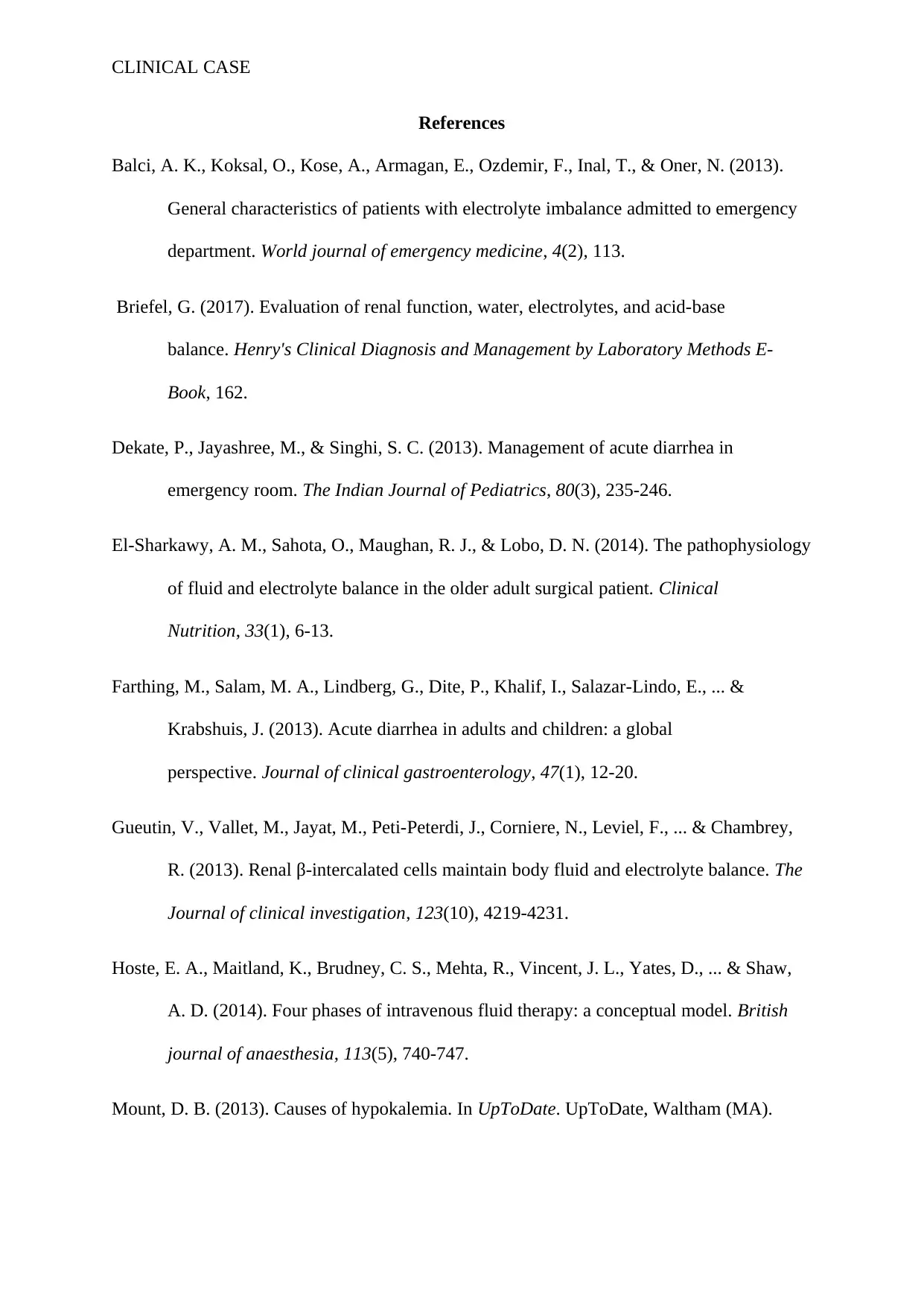
CLINICAL CASE
References
Balci, A. K., Koksal, O., Kose, A., Armagan, E., Ozdemir, F., Inal, T., & Oner, N. (2013).
General characteristics of patients with electrolyte imbalance admitted to emergency
department. World journal of emergency medicine, 4(2), 113.
Briefel, G. (2017). Evaluation of renal function, water, electrolytes, and acid-base
balance. Henry's Clinical Diagnosis and Management by Laboratory Methods E-
Book, 162.
Dekate, P., Jayashree, M., & Singhi, S. C. (2013). Management of acute diarrhea in
emergency room. The Indian Journal of Pediatrics, 80(3), 235-246.
El-Sharkawy, A. M., Sahota, O., Maughan, R. J., & Lobo, D. N. (2014). The pathophysiology
of fluid and electrolyte balance in the older adult surgical patient. Clinical
Nutrition, 33(1), 6-13.
Farthing, M., Salam, M. A., Lindberg, G., Dite, P., Khalif, I., Salazar-Lindo, E., ... &
Krabshuis, J. (2013). Acute diarrhea in adults and children: a global
perspective. Journal of clinical gastroenterology, 47(1), 12-20.
Gueutin, V., Vallet, M., Jayat, M., Peti-Peterdi, J., Corniere, N., Leviel, F., ... & Chambrey,
R. (2013). Renal β-intercalated cells maintain body fluid and electrolyte balance. The
Journal of clinical investigation, 123(10), 4219-4231.
Hoste, E. A., Maitland, K., Brudney, C. S., Mehta, R., Vincent, J. L., Yates, D., ... & Shaw,
A. D. (2014). Four phases of intravenous fluid therapy: a conceptual model. British
journal of anaesthesia, 113(5), 740-747.
Mount, D. B. (2013). Causes of hypokalemia. In UpToDate. UpToDate, Waltham (MA).
References
Balci, A. K., Koksal, O., Kose, A., Armagan, E., Ozdemir, F., Inal, T., & Oner, N. (2013).
General characteristics of patients with electrolyte imbalance admitted to emergency
department. World journal of emergency medicine, 4(2), 113.
Briefel, G. (2017). Evaluation of renal function, water, electrolytes, and acid-base
balance. Henry's Clinical Diagnosis and Management by Laboratory Methods E-
Book, 162.
Dekate, P., Jayashree, M., & Singhi, S. C. (2013). Management of acute diarrhea in
emergency room. The Indian Journal of Pediatrics, 80(3), 235-246.
El-Sharkawy, A. M., Sahota, O., Maughan, R. J., & Lobo, D. N. (2014). The pathophysiology
of fluid and electrolyte balance in the older adult surgical patient. Clinical
Nutrition, 33(1), 6-13.
Farthing, M., Salam, M. A., Lindberg, G., Dite, P., Khalif, I., Salazar-Lindo, E., ... &
Krabshuis, J. (2013). Acute diarrhea in adults and children: a global
perspective. Journal of clinical gastroenterology, 47(1), 12-20.
Gueutin, V., Vallet, M., Jayat, M., Peti-Peterdi, J., Corniere, N., Leviel, F., ... & Chambrey,
R. (2013). Renal β-intercalated cells maintain body fluid and electrolyte balance. The
Journal of clinical investigation, 123(10), 4219-4231.
Hoste, E. A., Maitland, K., Brudney, C. S., Mehta, R., Vincent, J. L., Yates, D., ... & Shaw,
A. D. (2014). Four phases of intravenous fluid therapy: a conceptual model. British
journal of anaesthesia, 113(5), 740-747.
Mount, D. B. (2013). Causes of hypokalemia. In UpToDate. UpToDate, Waltham (MA).
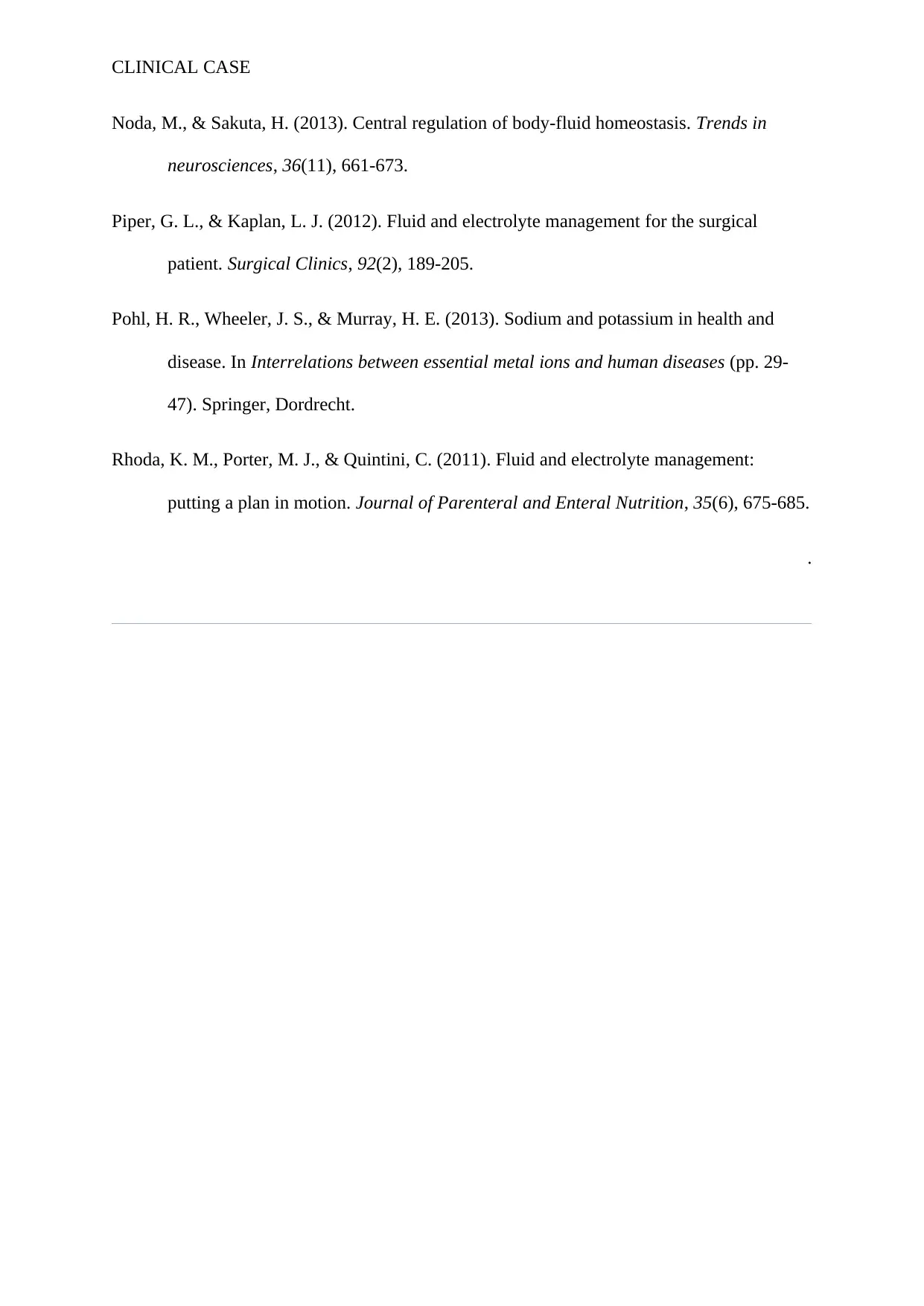
CLINICAL CASE
Noda, M., & Sakuta, H. (2013). Central regulation of body-fluid homeostasis. Trends in
neurosciences, 36(11), 661-673.
Piper, G. L., & Kaplan, L. J. (2012). Fluid and electrolyte management for the surgical
patient. Surgical Clinics, 92(2), 189-205.
Pohl, H. R., Wheeler, J. S., & Murray, H. E. (2013). Sodium and potassium in health and
disease. In Interrelations between essential metal ions and human diseases (pp. 29-
47). Springer, Dordrecht.
Rhoda, K. M., Porter, M. J., & Quintini, C. (2011). Fluid and electrolyte management:
putting a plan in motion. Journal of Parenteral and Enteral Nutrition, 35(6), 675-685.
.
Noda, M., & Sakuta, H. (2013). Central regulation of body-fluid homeostasis. Trends in
neurosciences, 36(11), 661-673.
Piper, G. L., & Kaplan, L. J. (2012). Fluid and electrolyte management for the surgical
patient. Surgical Clinics, 92(2), 189-205.
Pohl, H. R., Wheeler, J. S., & Murray, H. E. (2013). Sodium and potassium in health and
disease. In Interrelations between essential metal ions and human diseases (pp. 29-
47). Springer, Dordrecht.
Rhoda, K. M., Porter, M. J., & Quintini, C. (2011). Fluid and electrolyte management:
putting a plan in motion. Journal of Parenteral and Enteral Nutrition, 35(6), 675-685.
.
⊘ This is a preview!⊘
Do you want full access?
Subscribe today to unlock all pages.

Trusted by 1+ million students worldwide
1 out of 9
Related Documents
Your All-in-One AI-Powered Toolkit for Academic Success.
+13062052269
info@desklib.com
Available 24*7 on WhatsApp / Email
![[object Object]](/_next/static/media/star-bottom.7253800d.svg)
Unlock your academic potential
Copyright © 2020–2025 A2Z Services. All Rights Reserved. Developed and managed by ZUCOL.





